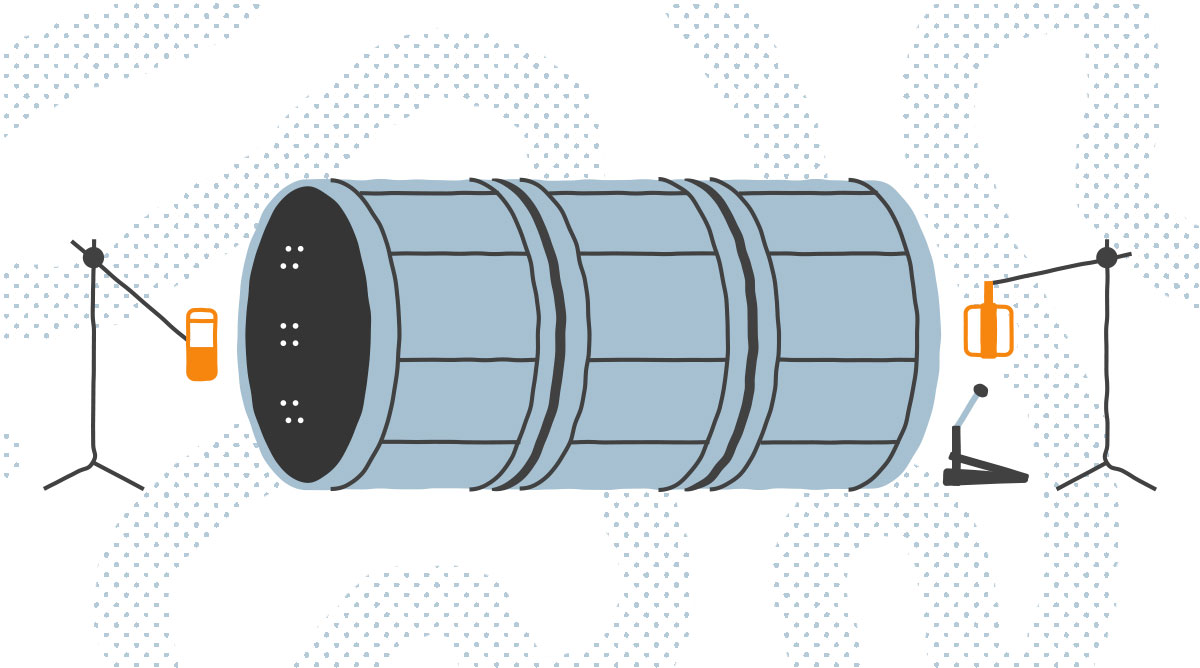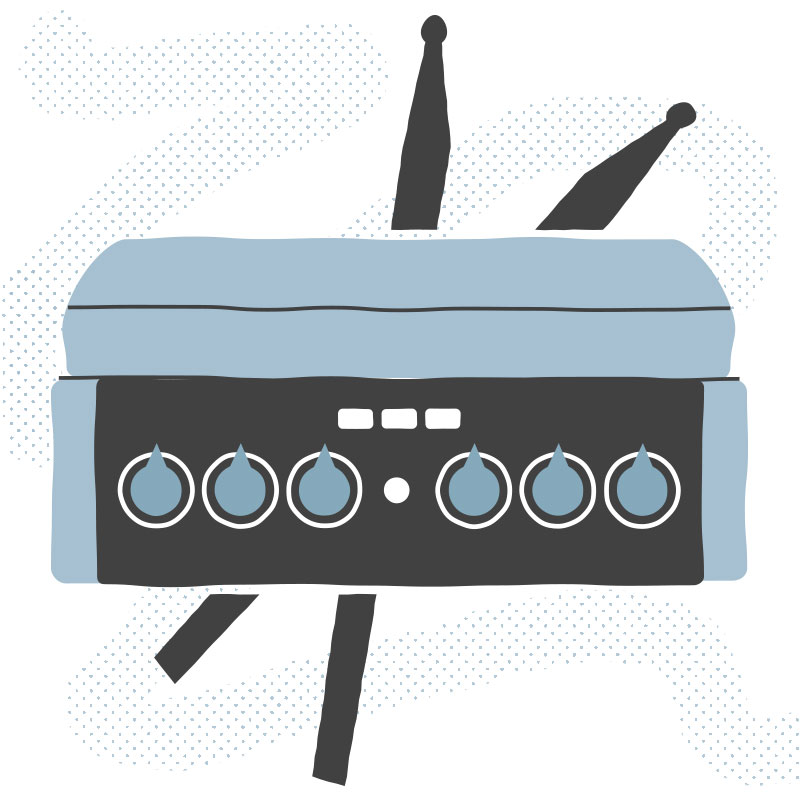Take a look through any blog, magazine, or YouTube channel that has anything to do with recording, and chances are you'll find plenty of tutorials that seek to explain the best way to record a drum set. The sound of the drum track can be the single most-defining component of a given song. And different rhythmic textures—acoustic or electric, live or sequenced—have defined entire genres of music. The fact that so much educational and practical effort has been committed to crafting and capturing ideal drum sounds is hardly surprising.
But for all this discussion of the ideal recording methods, it's often those drum sounds produced through experimental techniques, happy accidents, or spur-of-the-moment necessity that yield something truly special. Today, we're taking a look at six such instances.
Nevermind and In Utero are both amazing and distinct-sounding records with drum tones that do much to define their character. On In Utero the band had engineer Steve Albini—who's known for his pummeling drum sounds—behind the board to dial things in, but it was on Nevermind with Butch Vig that one of the band's craftier studio moments occurred.
Vig expanded the sound of Dave Grohl's bass drum by placing an elongating tunnel of other drum shells in front of his main kick drum, with an AKG D12 near the beater and a Neumann U 47 Fet at the tunnel's end. The added depth accentuated the sound of the drum going into the mic, extending the low-end while staying relatively isolated from the room sounds and the rest of the kit. It also didn't hurt to have Grohl kicking the Foo out of the batter head.

With all due deference to Giorgio Moroder and many underground progenitors, the Bee Gees' contribution to the Saturday Night Fever soundtrack is likely the music that most people think of when they think disco. And if pulsing, four-on-the-floor drum beats are the most crucial component of the disco sound, then it's not too much of a stretch to say that the drum tracks on songs like "Stayin' Alive" and "More Than a Woman" rank as some of the most central musical artifacts of the entire era, at least in the popular consciousness. It just so happens that these very drum tracks were created with a bit of last-minute studio ingenuity.
As the story goes—which is recounted in excellent detail in this Sound On Sound profile—the band was recording at Château d'Hérouville in France. When drummer Dennis Byron had to skip back to England following the death of his father, the band tried to record to the fixed rhythm of a crude drum machine on a Hammond organ. Unsatisfied with the result, engineer Karl Richardson and producer Albhy Galuten had the clever idea of copying a two-bar segment of the live drums from the already tracked "Night Fever" over and over again to create a drum loop.
As Richardson later recounted in the Sound On Sound piece: "The tape was over 20 feet long and it was running all around the control room—I gaffered some empty tape-box hubs to the tops of mic stands and ran the tape between the four-track machine and an MCI 24-track deck, using the tape guides from a two-track deck for the tension. Because it was 4/4 time—just hi-hats and straight snare—it sounded steady as a rock, and this was pre-drum machine."
Richardson goes on to explain that between all the copying from the original four-track to a new half-inch tape loop, the final product was at least third-generation, with badly worn tape heads further degrading the audio. He EQ'd the whole works to brighten everything up, and later, drummer Byron came back and overdubbed toms and additional cymbals. The band gave credit to Bernard Lupé as the drummer on "Stayin' Alive" as an homage to Bernard Purdie.
Through all of this studio splicing and re-recording, the sessions yielded one of the most danced-to tracks in history on the back of two bars of entirely locked-in live drums. Alongside the work of other disco pioneers, like Moroder's repetitious beats for Donna Summer, this prominent, looped drum track not only defined its era, but in it, you can hear the birth of many future dance genres to come.
When most music snobs think of lo-fi music they probably think of records from indie rock mainstays like Guided By Voices or the first half of The Mountain Goats' catalog—those recordings that lean into amateur technique and imperfections like cassette tape hiss, background noises, and the birds chirping outside a bedroom studio window finding their way onto a take. What probably doesn't come to mind is the arena-filling, globe-spanning classic rock of The Rolling Stones.
In the '60s though, during the band's ascent, several of their hits were built around Keith Richards' late-night hotel recordings of an acoustic guitar going into an overloading cassette recorder, creating an irreplaceable blown-out quality that was then rerecorded through amplifiers in a proper studio. Keith has talked at length about using this technique on songs like "Jumpin' Jack Flash" in various interviews and his autobiography, Life.

For the recording of "Street Fighting Man" from 1968, the lo-fi credentials go a step further to include Charlie Watts' drum part. Also recorded into the same tape recorder as the guitars, Watts played the drum part on essentially a toy travel drum kit that packed up into a suitcase.
As Watts describes in the coffee table book, According to the Rolling Stones, the 1930s' London Jazz Kit Set "came in a little suitcase, and there were wire brackets you put the drums in; they were like small tambourines with no jangles. The whole kit packs away, the drums go inside each other, the little drum goes inside the snare drum into a box with the cymbal. The snare drum was fantastic because it had a really thin skin with a snare right underneath, but only two strands of gut.''
If you listen to the track, however, the drums still sound huge. It's not entirely clear if this is a product of the same re-amping approach Keith used on his guitars, or if there is some tom and bass drum overdubbing going on as well.
It's been said that the drum fill on Phil Collins' "In the Air Tonight" was the revolutionary moment that brought about the era of gated reverb drum recording. Today, gated reverb on drums and on snare drums in particular have become just another option in the studio, and plenty of DAWs and reverb plugins come stocked with presets on how to achieve this most '80s of effect. In its origin, though, the discovery of gated reverb on drums was just another happy studio accident.
The accident in question actually occurred in an earlier recording in which Collins was guest drumming for Peter Gabriel for a song called "The Intruder." The whole discovery centered a shiny new SSL console that had a compressor and noise gate on every channel. The studio was also set up with a mic in the ceiling of the live room, which was itself heavily compressed. When you record drums in a loud, boomy room and compress it, you get some massive results, which caught the ear of Collins and producer Hugh Padgham.
From there, the team experimented a bit further. Padgham explains in this MusicRader interview: "When I pushed the button for the compressor on the console, there was a noise gate already in the chain and he stopped and the sound suddenly went to nothing..."
The result was a whip-like drum sound that goes from huge to silent almost immediately. Collins recruited Padgham to record his first solo album Face Value soon thereafter, opting to use their newly discovered drum technique in an even more cavernous live room to yield such singles as "In the Air Tonight," and before long, gated reverb settings were becoming standard in the first generation of digital reverb outboard units.
For a much more engaging take on this reverb tale that illustrates the full history and legacy of gated reverb, watch the video below from the always-inspiring Estelle Caswell of Vox.
While Paul Simon's discography is replete with fantastic drum tracks, as heard on "50 Ways To Leave Your Lover," "Obvious Child," and other songs, the dulcet tones of Simon & Garfunkel aren't exactly synonymous with big drum sounds. By the time of the recording of their final album, Bridge Over Troubled Water, however, the duo was at the forefront of studio techniques. They were, for instance, one of the first acts to use 16-track recording.
On one of the album's classic tracks, "The Boxer," during the campfire-friendly "lie la lie" refrain, there are unmissable drum hits played by the late Hal Blaine, who later described them as "... a cannon shot! Which was just the kind of sound we were after."
The approach taken by producer Roy Halee in the sessions for the song involved placing Blaine's kit in the hallway of the studio next to an elevator shaft to take advantage of the natural reverb of the space. According to Hal, "As I'm crashing down, the door opens and there's an elderly rent-a-cop, I guess. ... And as I came down with this explosion that shook the building, it's like he died or he thought he was killed. The doors closed, we never saw him again."
There's another noteworthy bit of rhythmic creativity on Bridge Over Troubled Water found on "Cecilia." The distinct drum part on that song come from a party where the duo and some pals used a home tape recorder to capture them slapping their thighs and banging on things in the room. Simon and Halee identified a compelling snippet from the tape and created a loop with some added elements in the studio.
And what listicle about classic drum recordings would be complete without a reference to the legend of Led Zeppelin's "When the Levee Breaks."

The story has been told many times before and in longer and more thoughtful terms than presented here, but in short, the cavernous sounds that propel this blues-rock classic are the result of a prime recording location, some thoughtful mic placements, and the creative use of a Binson Echorec delay unit.
Recorded at Headley Grange, the process involved putting Bonzo and his kit in the lobby of the house, placing two Beyerdynamic M160s, treated with a hearty dose of compression, at the top of the first stairwell, and running the works through the Binson. The result is a massive, unmistakable drum sound where the applied echo expands the recorded track to an incredible size and depth.
As arguably the greatest rock drum track from the inarguably greatest rock drummer, the process at work is not without controversy. Some people assume it was just the sound of the room and reject the role of the Binson. For more on this conversation, check out this video from the always interesting Rick Beato.
Do you have your own favorite tales of how other classic drum tracks were made? Let us know in the comments.
